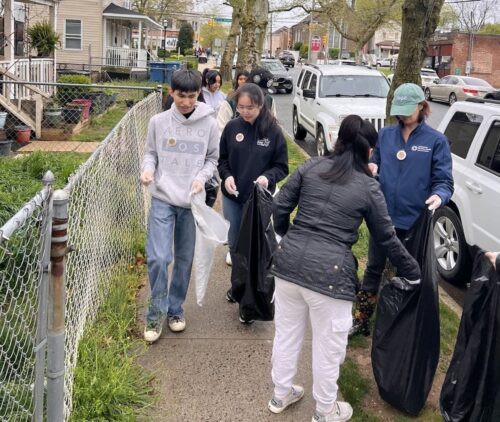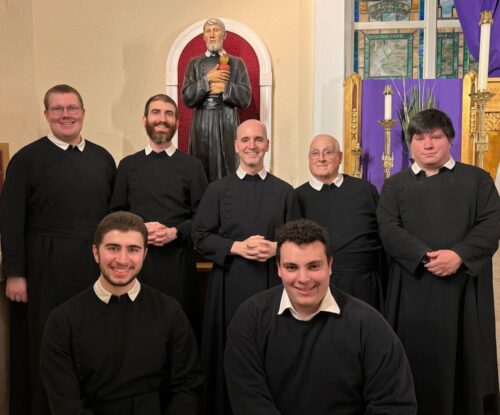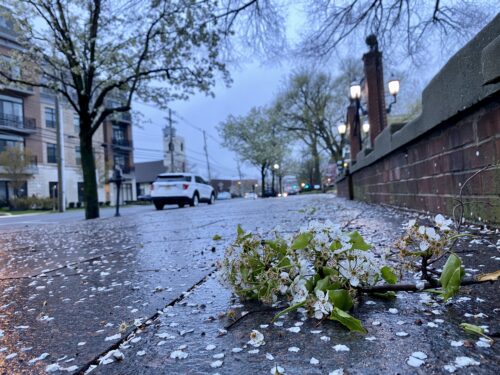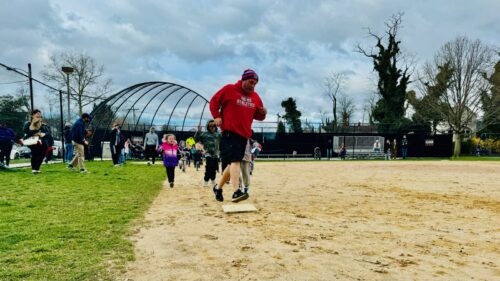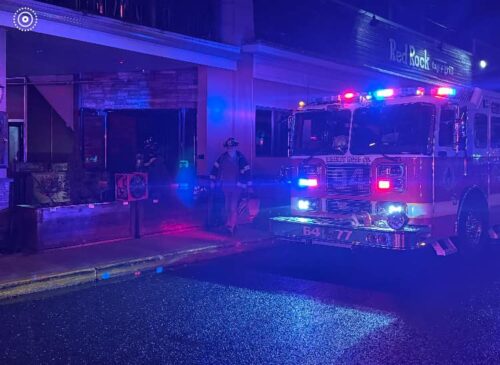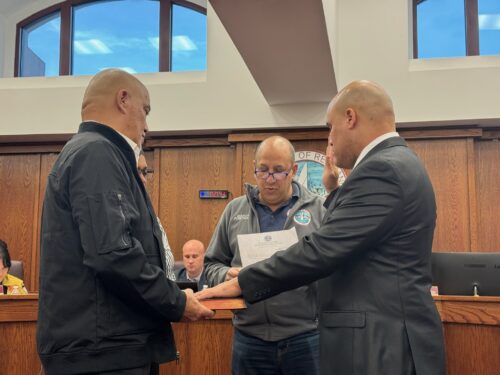
By JOHN T. WARD

Yes, according to eyewitnesses. No, according to a JCP&L spokesman – and the sidewalks downtown are as safe as ever.
Through spokesman Ron Morano, the electrical utility on Monday disputed claims that its equipment had exploded up to four times outside the St. James Church/Red Bank Catholic High complex, as reported on redbankgreen and elsewhere.
The claim that there were no explosions surprised police Chief Darren McConnell, who said he saw two himself as he stood in the cordoned-off stretch of Broad Street shortly after 3 p.m.
“I don’t know what they’re defining as an explosion,” McConnell said. “I saw what happened, and what happened looked an awful lot like an explosion to me.”
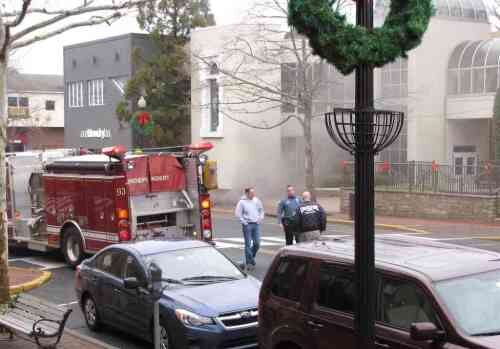
“I was there, you were there,” McConnell said to this redbankgreen reporter, who also witnessed an explosion. McConnell, who snapped some photos with his cellphone, said he wished he’d had video of the incident.
“So what went ‘boom?'” asked a volunteer firefighter who asked not to be named. The firefighter told redbankgreen he and others were indoors inspecting the church and school and “we heard the last one” of the blasts.
“I would say it was some type of explosion,” said first deputy fire chief Chris Soden, who was in the street at the time.
The divergent characterizations of the incident arose as local officials sought to determine just what had happened, and whether the safety of pedestrians and motorists might be impacted. Stretches of Broad, Monmouth and other streets downtown have no utility poles because their stores, restaurants and other businesses are served by underground electrical equipment.
JCP&L’s Morano said the incident does not suggest a possibility that underground electrical infrastructure downtown might be a danger, because there was nothing to explode in the “handholes,” or shallow manholes, in front of the church and school, and thus, nothing could have exploded.
Morano said a “secondary wire” experienced a fault that caused it to burn, sending smoke out of two handholes. The access pits are located about 100 feet apart along the curb in front of the church and school.
Contrary to a statement issued by the borough police Sunday that a transformer had exploded underground, “there was no other equipment” in the pit, Morano said. A transformer steps down voltage as electricity moves from the power grid to customers.
Morano said JCP&L was investigating the cause of the fault.
But if there was no explosion, how was the “handhole” cover knocked ajar, and the surrounding bricks blown out of the ground?
“That can happen” in the event of a fault and fire as pressure builds up and is eventually released, Morano said.
“‘Explosion’ is your description of the event,” he said. “‘Explosion’ implies things were moved and there was damage.”
After being sent photos showing the steel manhole cover knocked askew and paving bricks displaced, Morano said they were not evidence of an explosion. “That’s from built-up smoke and fire,” he said.
By the time redbankgreen arrived at 3:18, however, the manhole cover and surrounding bricks had already been displaced, photos show. The blast witnessed by this reporter and McConnell occurred several minutes later. Accompanied by a loud noise, it appeared to send a flash of flame and smoke several feet into the air.
Borough Administrator Stanley Sickels, a 40-year veteran of the fire department, said the flammable gases created by burning cable insulation may have ignited and then reignited as oxygen rushed into the chamber.
JCP&L received its first call about the incident at 3:10 and had a crew on the scene at 3:30, Morano said.
“There were some rather large pops and some manhole covers that were removed from the sidewalk,” said Fire Chief Joe Lauterwasser, who responded to the call less than 90 minutes after being sworn into the post. “They blew, but I don’t know if I would characterize them as explosions,” which he associates with flying debris and shrapnel, he said.
Mayor Pasquale Menna said Monday evening that he had sat in on several conference calls with JCP&L officials throughout the day to discuss safety concerns.
“I believe they’re taking a rather legal approach to the definition of ‘explosion,'” Menna told redbankgreen. “Trapped gases that cause projectiles to be dislodged… if you don’t all that an explosion, I don’t know what you call it.”
He said the borough was pressing the utility to step up inspections of all underground facilities, and called on the state Board of Public Utilities to get behind the borough’s request.
“I think we made some reasonable recommendations,” Menna said. “People need to be reassured, and hopefully, JCP&L will take our suggestions to heart.” A press release issued by the borough Monday evening referred to “a small explosion Sunday afternoon that dislocated several bricks on Broad Street.” [See below]
Sickels said the initial outcome of the discussions was satisfactory.
There’s no safety issue suggested by what happened Sunday, Morano said. Underground electrical infrastructure is installed “all across the country,” and JCP&L’s “meets national electrical safety code standards. They are safe.”
Sickels said Sunday’s underground fire might have been detected sooner, before anything erupted, if it hadn’t been a “dreary afternoon” at the tail end of a long holiday weekend, depressing foot traffic. And underground service is no less safe than equipment mounted on poles, which does catch on fire and pop, he said.
No one was injured in the incident. The high school and adjoining St. James Elementary School remained closed Monday because of the event, and were scheduled to reopen Tuesday.
The incident led to 260 customers losing electrical power, Morano said. All but 10 had it back on by 9:20 p.m., and the remainder were back to normal by 6 a.m., he said.
Here’s the full statement issued by the borough:
Power restored after JCP&L equipment failure on Broad Street
Borough Officials are calling for the inspection of all Jersey Central Power & Light underground equipment following an incident on Broad Street Sunday, January 4, 2015.
A fault in a secondary wire produced a large amount of smoke and a small explosion Sunday afternoon that dislocated several bricks on Broad Street. There was no additional property damage or injuries. JCP&L personnel responded immediately, identified the problem and worked through the night to restore power to the area. All damaged wiring has been replaced.
Borough Officials have sent a message to JCP&L/First Energy Corporation with copy to the Board of Public Utilities requesting that JCP&L/First Energy inspect all of their underground facilities within the Borough to help ensure no other hazardous conditions exist.
While this was a minor explosion, these situations can be more dangerous. In most cases, the following factors lead up to this type of explosion:
Underground cables become frayed from aging, corrosive chemicals, overload or rats biting them. These cables carry on the order of 13,000 volts of electricity.
These electrical wires heat up the paper, lead and rubber insulation.
The insulation smolders and catches on fire, releasing gases.
The pressure from the gas builds up inside the manhole.
The electrical wires arc like a bolt of lightning and ignite the gases, causing the explosion.
Termination of the power eliminates the source of heat and contains the incident. The damaged area is isolated and power restored to as many customers as possible while the damaged sections of cable are replaced and full power service restored.



